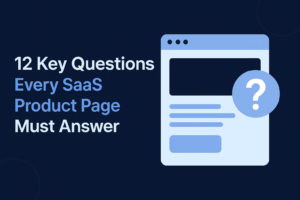In 2025, the way businesses approach search visibility is evolving rapidly, and for B2B SAAS companies, staying ahead requires a shift in strategy. Answer Engine Optimization (AEO) is emerging as a critical framework, moving beyond traditional search engine optimization to meet the demands of modern search behavior. This blog explores how AEO can drive success for B2B SAAS marketers, offering practical steps to adapt and thrive in this new landscape. By mastering AEO, your business can secure higher engagement, attract qualified leads, and maintain a competitive edge.
What is AEO and Why It Matters for B2B SAAS
AEO focuses on optimizing content to provide direct, concise answers to user queries, tailored for platforms that prioritize immediate responses over traditional search results. Unlike conventional SEO, which emphasizes keyword rankings and link-building, AEO targets the growing reliance on answer-driven systems—think voice assistants, featured snippets, and conversational search interfaces. For B2B SAAS companies, this shift is significant. Your audience—decision-makers, IT professionals, and business owners—often seeks quick, authoritative solutions to complex problems, such as “What’s the best CRM for enterprise scalability?” or “How does SAAS pricing impact ROI?”
The relevance of AEO lies in its ability to meet these needs efficiently. Research indicates that over 60% of search queries now generate instant answers, reducing the need for users to click through to websites. For B2B SAAS marketers, this trend presents both a challenge and an opportunity: fewer clicks mean less direct traffic, but optimized content can position your brand as the go-to source within those answers, building trust and driving qualified leads over time.
The Changing Search Landscape in 2025
Search behavior in 2025 reflects a broader reliance on technology that prioritizes speed and precision. Voice search, for instance, continues to grow, with users asking detailed, conversational questions. Local queries, such as “Which SAAS provider serves small businesses near me?” are also on the rise, especially for B2B companies with regional clients. Meanwhile, search engines are increasingly favoring content that answers questions directly, often pulling from well-structured pages to populate featured snippets or voice responses.
For B2B SAAS, this evolution demands a rethink of how content is created and delivered. Traditional long-form blogs, while valuable, must now compete with concise, answer-focused formats that cater to impatient users. The goal isn’t just to rank on the first page—it’s to be the answer users hear or see without scrolling. This is where AEO becomes a game-changer, aligning your content with the way your audience searches and consumes information.
Key AEO Strategies for B2B SAAS Success
To leverage AEO effectively, B2B SAAS marketers need a clear, actionable approach. Below are five strategies to implement in 2025, each designed to enhance visibility, improve click-through rates, and drive traffic to your site.
1. Prioritize User Intent Over Keywords Alone
Understanding what your audience wants is the foundation of AEO. B2B SAAS buyers often have specific intents—researching solutions, comparing features, or seeking implementation advice. Instead of stuffing content with generic terms like “SAAS software,” focus on the questions they’re asking. For example, a query like “How does SAAS improve operational efficiency?” requires a direct response, not a broad overview.
Start by analyzing your current traffic data to identify common queries. Tools like Google Search Console can reveal the exact phrases driving visitors to your site. Then, craft content that answers those questions within the first 50 words, followed by deeper insights. This approach not only satisfies user intent but also increases the likelihood of appearing in answer-driven results, boosting your visibility.
2. Structure Content for Clarity and Scannability
Search engines and users alike favor content that’s easy to digest. For AEO, this means using clear headings, bullet points, and short paragraphs to break down complex topics. A B2B SAAS blog about “Choosing the Right Project Management Tool” could include an H2 like “Key Features to Look For,” followed by a bulleted list: integrations, scalability, and cost-effectiveness.
This structure helps search engines extract answers quickly, improving your chances of landing in featured snippets. It also keeps readers engaged, encouraging them to click through for more details. Pair this with a strong meta description—e.g., “Discover how to pick the best project management tool for your SAAS business in 2025″—to lift CTR from search results.
3. Leverage FAQ Pages for Targeted Answers
FAQ pages are a powerful AEO tool for B2B SAAS companies. They address common customer questions, such as “What’s the ROI of SAAS marketing tools?” or “How long does SAAS implementation take?” By organizing these into a dedicated section, you create a resource that search engines can easily pull from for instant answers.
To maximize impact, use structured data (schema markup) to tag your FAQs. This technical step signals to search engines that your content is answer-ready, increasing its chances of appearing in rich results. For example, a well-marked FAQ on “SAAS Security Features” could rank for voice searches like “What makes SAAS secure?”—a win for both traffic and authority.
4. Optimize for Voice Search and Conversational Queries
Voice search is reshaping how B2B buyers find solutions, especially on mobile devices. These queries tend to be longer and more natural, such as “Which SAAS platform is best for remote teams?” To rank for these, your content must mirror conversational language while staying concise.
Incorporate question-based headings throughout your blog—e.g., “Why Do Remote Teams Need SAAS?”—and answer them directly. Keep responses under 60 words to fit voice search preferences, then expand with supporting details. This tactic not only targets voice users but also aligns with the broader AEO goal of delivering fast, relevant answers.
5. Build Authority with Data-Driven Insights
Trust is critical for B2B SAAS buyers, and AEO rewards content that demonstrates expertise. Back your answers with original data, case studies, or industry statistics. For instance, a blog on “SAAS Trends for 2025” could cite a finding like “70% of enterprises plan to increase SAAS spending next year,” linking to a credible source or your own research.
This approach strengthens your brand’s credibility, encouraging search engines to feature your content as an authoritative answer. It also appeals to decision-makers who value evidence over opinion, driving higher engagement and shares—key factors for traffic growth.
Applying AEO to Your B2B SAAS Blog
Let’s put these strategies into practice with a hypothetical blog post: “How to Scale Your Business with SAAS in 2025.” Here’s how it could look:
- Opening Answer (50 words): “Scaling with SAAS in 2025 means leveraging automation, integrations, and analytics to streamline operations. Choose platforms with flexible pricing and robust support to grow efficiently.”
- H2: What Makes SAAS Scalable?
- Bullet points: Automation tools, API integrations, real-time data.
- H2: How to Pick the Right SAAS Solution
- FAQ-style: “What’s the cost of scaling with SAAS?” Answer: “Costs vary, but expect $50-$500/month based on features.”
- Data Point: “Studies show 65% of SAAS users report faster growth within six months.”
This format answers the query upfront, uses clear structure, and builds trust—perfect for AEO and B2B audiences.
Measuring AEO Success
To ensure your AEO efforts pay off, track specific metrics:
- Click-Through Rate (CTR): Monitor CTR in Google Search Console. A rise from 2% to 5% signals stronger appeal in search results.
- Featured Snippet Rankings: Use tools like Ahrefs to see if your content appears in position zero.
- Traffic Growth: Look for a 20-30% increase in organic visits within three months, a realistic goal for well-optimized posts.
- Engagement: Check time on page and bounce rate. Engaged readers (over 2 minutes) indicate content relevance.
Adjust your strategy based on these insights, refining titles and answers to match what resonates most.
Challenges and Solutions
AEO isn’t without hurdles. The rise of zero-click searches—where users get answers without visiting your site—can reduce direct traffic. Counter this by offering compelling reasons to click, like downloadable resources (e.g., “Get Our SAAS Scaling Checklist”). Another challenge is competition for answer spots. Stay ahead by regularly updating content with fresh data and targeting niche queries your competitors overlook, such as “SAAS for mid-sized logistics firms.”
Why AEO is the Future for B2B SAAS
The shift to AEO reflects a broader truth: search is becoming less about browsing and more about solving problems instantly. For B2B SAAS companies, this is an opportunity to connect with buyers at critical decision points. By delivering precise, trustworthy answers, you position your brand as a leader, even in a crowded market. In 2025, mastering AEO isn’t just a tactic—it’s a necessity for staying relevant and driving growth.
Next Steps for Your Business
Start by auditing your existing blog content. Identify posts that can be reworked with AEO principles—add question-based headings, tighten answers, and implement structured data. Then, plan new content around your audience’s top queries, using the strategies outlined here. Consistency is key: aim for one AEO-optimized post per week to build momentum.

vetrivel is an accomplished SEO and digital marketing expert with 5 plus years of experience. dedicated to providing readers with informative and engaging content.




